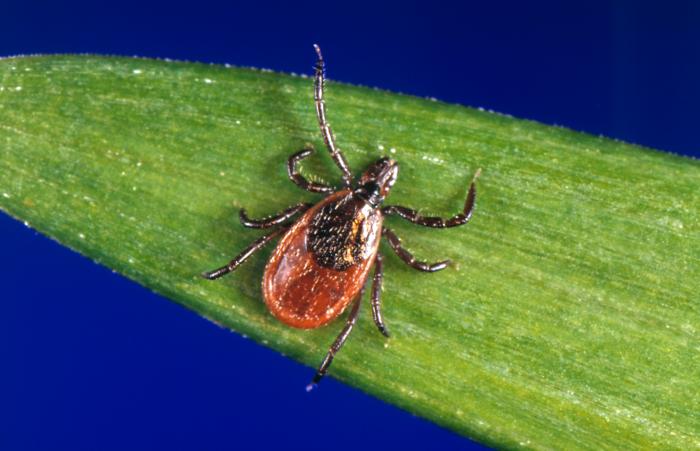As a science communications fellow at Tyson Research Center, Christian Fogerty embedded with the tick and wildlife ecology team to document their summer fieldwork. Here, he reflects on his experience and explains how it impacted his perspective on global health.
They say the early bird gets the worm. But how early, exactly, is “early”?

For Solny Adalsteinsson, staff scientist at Tyson Research Center, and her tick and wildlife ecology research group, early means 4 a.m. During the summer months the tick team hikes out into the oak-hickory forests at dawn to the symphony of birdsong and tree frogs. For Adalsteinsson, each summer offers another field season to collect data on a long-term project analyzing tick parasitism in birds. Each new field season also brings a new cohort of technicians and undergrads to help her out. This time around, her team got another addition – yours truly – to accompany them into the forest and be a fly on the wall. Or maybe more like a tick on the tree.
Most people have an instinctual aversion to ticks, stemming from a general human distaste for arthropods and their association with disease. But this human connection is just one aspect of a larger relationship between ticks and the environment. Other animals, such as deer and birds, host ticks as well. These host animals serve as different systems, or reservoirs, for the pathogens carried by the ticks to survive in and, potentially, be transmitted to humans. The tick team at Tyson studies how forest fires, specifically prescribed ones, affect birds and the ticks they host. This prescribed burning, a common land management strategy, has had positive impacts on ecosystem restorations. However, it isn’t well known how these fires affect the biodiversity of ticks, birds, and their associated pathogens. To shed light on this, Adalsteinsson takes her field team out to quantify the tick abundances in birds that live in both burned and unburned habitats, ultimately comparing their observations to larger data sets to make stronger conclusions about the complex relationships involved. These interactions are all delicate enough to be easily misunderstood, thus, careful, long-term study is necessary. The only way to do this is to hike out into the forest early in the morning and look at the birds themselves.

I thought I was a morning person, but when you get up so early that the distinction between early morning and late night is blurred, this becomes irrelevant. Making it out to the plots of land at Tyson by 5 a.m. was certainly a challenge, but fortunately a shared one. Adalsteinsson’s team is overwhelmingly cohesive and positive, and that shared energy motivates them to get out into the forest, set up the near-invisible mist nets, and begin waiting for birds as dawn breaks. Elise Nishikawa, the team technician, bubbles over with endless enthusiasm and an encyclopedic knowledge of ornithology. The other team members, Anahi Gamboa, Derek McFarland, Rachel Novick, and Rossana Romo, are undergraduate and graduate fellows from various institutions including WashU, trying on the title of researcher for a summer under the wing of Adalsteinsson and Nishikawa.
“Processing” is the word that gets tossed around to describe how the team studies the birds. Once a bird is caught, whether it’s a chickadee, blue jay, titmouse, or a cardinal, one of the team members unfurls it from the mist net and gingerly places it into a cloth bag. Each bird is taken over to a tarp and scrutinized with care under the watchful eyes of the researchers. One lucky team member holds the bird and begins recording stats: sex, age, wing length, blood sample, band, and tick collection. Some birds are docile and calm while others are less so, but one constant is the delicate yet firm control the researchers have with each animal. Some, like the blue jay, immediately wreak havoc when drawn from the bag, unleashing a torrent of wing flapping or excrement firing. But the researchers are steady in their analysis. They display a tender respect for each bird, collect its data, and promptly release it back into the oak-hickory forest.

One complicating aspect of fieldwork at Tyson is the sheer number of ticks. Every field team is intimately aware of the steps that must be taken to minimize exposure to them, so the preparation for a day in the field isn’t quite like getting ready for a few hours of hiking. For a team that specifically studies ticks, encounters are inevitable, so the tick team members head out into the field clad with anti-tick wear: pants tucked into long socks covered by impermeable calf sleeves called gaiters, clothing treated with the proper chemicals, and a mutual agreement among team members to recognize ticks on each other and promptly capture them with an extensive arsenal of duct tape.
Two years ago, eight pairs of 2.5-hectare plots were chosen as the sites for Adalsteinsson’s project. Out of each pair, one plot was burned while the other was left undisturbed. The birds within a given plot generally live there throughout the summer months; thus, the ticks found on these birds are assumed to be from the same plot. Adalsteinsson takes her team out to each plot pair twice a field season, in early and late summer, to collect data during different tick life stages and determine whether fire affects nymphal stage ticks differently than the younger larval stage ones.
This field season marks two years since the last prescribed burn, and the ticks have responded, albeit indirectly. Prescribed burning had once been proposed as a land management strategy to reduce tick populations. Set fire to a plot of land, the idea goes, and the ticks should burn away along with everything else. But interactions between ticks and their host animals complicate the story. Studies using different methodologies and land areas have shown that some deer favor burned areas over unburned plots, thus increasing tick (specifically lone-star tick) abundances in those burned sites. These lone-star ticks, identified by a signature white dot on their dark brown backs during the adult female stage, are different from the blacklegged ticks found on both deer and birds. Adalsteinsson’s research has already shown that blacklegged tick numbers on birds go down in the post-burn years, supporting the idea that prescribed burns could lower certain tick populations. But these results are preliminary and the field experiment hasn’t gone on long enough to make any conclusive claims.
Lone-star ticks and blacklegged ticks host different pathogens. In Missouri, the blacklegged ticks, formally known as Ixodes scapularis, host Lyme disease but rarely transmit it to humans since they are of a different genotype than their counterparts in New England, the upper Midwest, and the mid-Atlantic. The lone-star ticks host lesser-known diseases such as Heartland and Bourbon virus, two deadly pathogens that are less common, but on the rise over the past decade. The data collected over the field season will contribute to a long-term data set that could shed light on the complex interactions between humans and their environment – specifically, how a seemingly simple land management strategy can have an enormous, complicated effects on bird, tick, and pathogen communities. This idea highlights one of the motivations for Adalsteinsson’s work: an initiative known as One Health.

Broadly speaking, One Health focuses on increasing collaborations across disciplines to improve the health of all living things. Adalsteinsson co-teaches a course on the initiative at WashU with Sharon Deem, wildlife veterinarian and epidemiologist at the St. Louis Zoo. After studying the impacts of a prescribed forest burn on one of the most significant disease vector organisms on the planet, it’s easy to see how the holistic lens of One Health can help us understand the environment. Forest leaf cover and animal abundance affect tick populations; ticks spread diseases to humans and other wildlife; and human activity affects tick populations. Everything is linked, and it takes more than one discipline, let alone one scientist, to understand these links.
“One thing we’re really trying to get a handle on is how people can better interact with their environment to promote more sustainable ecosystems in terms of both human and animal health,” said Adalsteinsson. “But there are infinite questions and complexities.”




